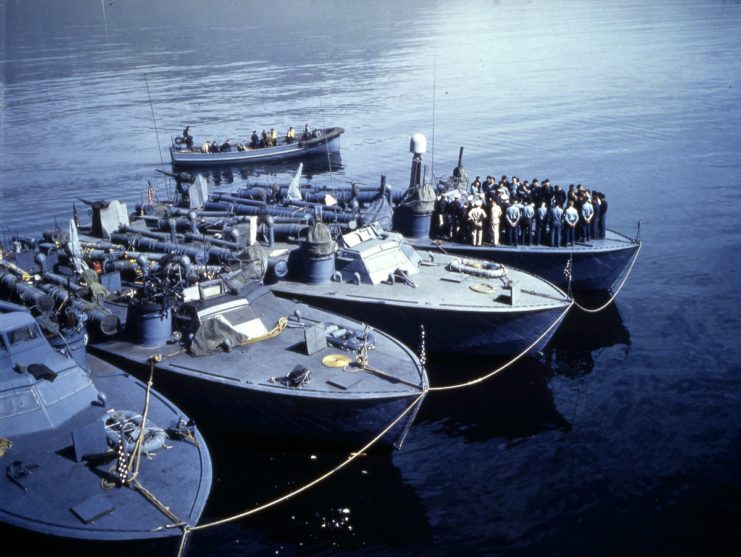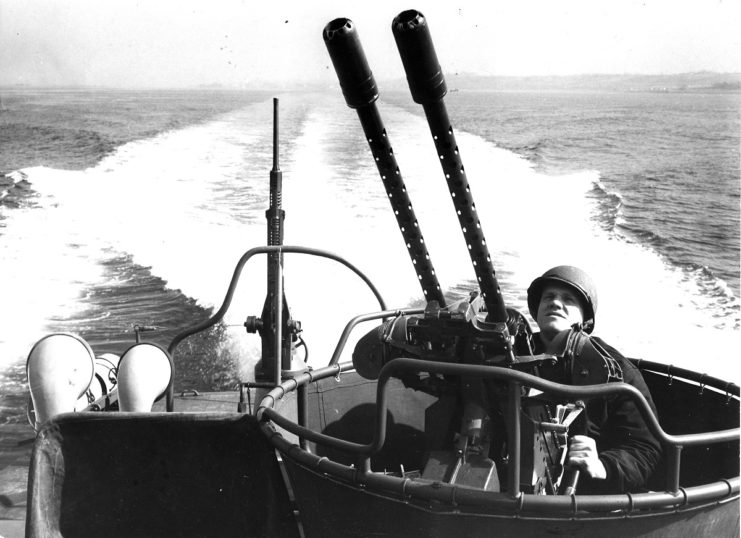During WWII the US realized their PT boats had more potential than just simple torpedo dispensers. These rapid machines proved deadly as highly mobile machine gun platforms that could rush and strafe enemy vessels and positions before quickly fleeing. Japanese inter-island barges were particularly vulnerable to these boats. To further increase their capacity for destruction, the Elco Thunderbolt was developed.
The PT boat was an extremely powerful tool used by the US Navy during WWII. The idea of a fast, lightweight, and maneuverable boat was taken seriously during WWI by both the British and the US, but the end of the war mostly ended their development.
PT boats in WWII


WWII PT boats incorporated design elements borrowed from powerboat racing and were fitted with high-powered engines. Usually, three V12 petrol engines were used to attain speeds of up to 50 knots.
The boats were initially designed to function as torpedo craft (as evidenced by their names; PT meaning patrol torpedo), but they were given extra offensive weapons throughout the war. They were particularly useful during the fighting in the New Guinea area, where they would hunt Japanese barges moving through the shallow waters between islands at night to deliver supplies.
Because these barges operated in shallow waters, large American ships were unable to get close to them, so they sent in PT boats instead. However, it was soon realized that their torpedoes were often ineffective against the barges as they simply passed underneath them. This prompted the use of increased firepower to blast the enemy vessels away before quickly fleeing.
The PT boats were also used to rescue shipwreck survivors, coordinate air-sea rescue operations, lay mines, and smoke screens, destroy mines, and carry out intelligence or raider operations. These boats earned a fearsome reputation among the Japanese, who called them “devil boats.”
PT boats received field modifications over the course of the war, and eventually carried a huge assortment of firepower, including 16 five-inch rockets, torpedoes, depth charges and multiple .50 caliber machine guns, and 40 mm cannons. In this setup, PT boats had the most “firepower-per-ton” of any Navy vessel.
However, as these boats were relatively small, measuring only 24 meters in length and displacing 60 tons, they were limited in how many weapons they could carry. In a bid to solve this problem, the Elco Thunderbolt turret provided immense firepower in a small package.
Elco Thunderbolt
The Elco Thunderbolt was a small turret developed by Elco, one of the two companies that produced the PT boats (the other being Higgins, the manufacturer of the iconic landing craft). The turret’s size and dense concentration of firepower reduced weight and reduced the number of operators needed to fire the guns.
They came in various different arrangements.
One of the earlier versions of the turret was fitted with six M2 .50 caliber machine guns and two Oerlikon 20 mm cannons. Another used four Oerlikons and two .50 calibers. With all guns firing, these turrets could unleash a devastating rain of fire upon any unfortunate enemy. The 20 mm cannons were to penetrate the hulls of vessels, while the smaller .50 caliber machine guns were for the crew on the decks.
All of these weapons could be operated by just a single person.
As it arrived near the end of the war, the Elco Thunderbolt saw little use and as a result, it is not well known. However, the US Navy uses a similar system for their 25 mm Bushmaster cannons today.


Leave a Comment